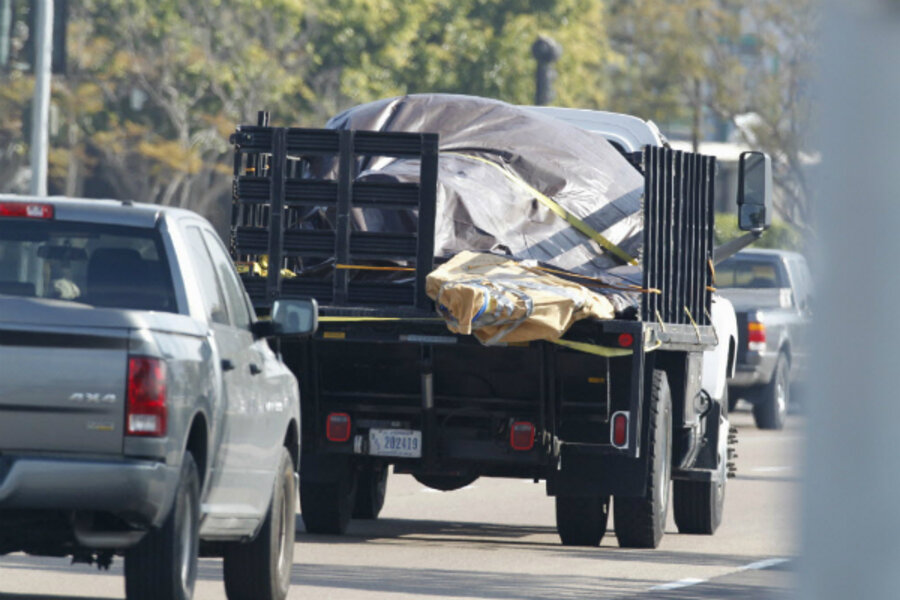Drones on the US border: Are they worth the price?
Loading...
| El Paso, Texas
The grounding of the drone fleet that watches over America’s borders after a crash last week is highlighting a program that continues to expand, though questions remain about its effectiveness.
The crash involved a mechanical failure on a Predator B drone operated by US Customs and Border Protection (CBP). When operators determined that the drone would be unable to reach its home base in Sierra Vista, Ariz., they crashed it into the sea.
In recent years, CBP has ramped up its drone program, which enjoys backing from both sides of the aisle in Congress. Indeed, with Republicans on Capitol Hill insisting that increased border security be an integral part of any immigration reform, the drone program could expand further in the years ahead.
Yet some border-watchers question whether the unmanned aircraft program contributes enough to border security to justify its large price tag. Moreover, civil libertarians note that CBP is increasingly using its drones to support local, state, and federal law enforcement agencies, with 700 such missions between 2010 and 2012, according to one report.
CBP defends the drones as helpful tools that the agency needs to improve situational awareness on the border. But as Congress nears a reckoning on immigration reform, the crash raises the question of what drones can do on America’s southern border.
“It’s a moment where the program should be reexamined, but there have been so many moments over the years,” says Tom Barry, director of the TransBorder Project at the left-leaning Center for International Policy.
Counting the recently lost drone, CBP maintains a fleet of 10 Unmanned Aerial Vehicles (UAVs). The Federal Aviation Administration is still developing regulations to incorporate widespread use of drones into US airspace, but CBP has permission to operate its vehicles along the border.
Predator drones can stay airborne for up to 20 hours and have surveillance equipment that CBP officials say is crucial to helping them know what’s going on at the border. Synthetic-aperture radar, for example, can identify changes in the landscape, such as footprints and tire tracks of people who may have crossed the border otherwise unseen. This helps border patrol agents find gaps and better position themselves.
But some analysts have cast doubt on drones’ contributions. Between 2005 and 2011, drones contributed to about 0.01 percent of apprehensions of those suspected of illegal activity and helped interdict 46,600 pounds of marijuana (equal to the amount of marijuana seized by CBP agents in Arizona in about 13 days, on average), according to a report by Mr. Barry. Using a drone to assist in apprehensions costs an average of $44,800 per person and $7,214 per pound of marijuana, Barry found.
“As far as I can tell, the US government does not have a comprehensive risk-reward strategy for border enforcement,” says Josiah Heyman, a professor of anthropology who specializes in border studies at the University of Texas at El Paso. “At each step I think that this stuff is driven by political process rather than by some kind of systematic risk assessment methodology.”
Such high costs have sometimes proven prohibitive. In 2011, when CBP had seven drones, it flew them for only about one-third of the minimally acceptable mission hours, according to an audit by the Department of Homeland Security’s Office of Inspector General.
Bad weather factored into grounding drones, but the report also said the agency was not prepared to deal with the overhead required to maintain UAVs. Keeping a Predator drone in the air costs about $3,200 per hour and requires about an hour of maintenance for each hour of flight. In fiscal year 2010, CBP had to divert $25 million from other programs to address operations and maintenance budget shortfalls in the program.
CBP now says it’s meeting all its internal flight-hour goals. During the last fiscal year, the organization’s 10 drones flew approximately 5,102 hours (up from 3,909 in 2011). Considering the increase in drones, the improvement may seem marginal, but a senior CBP official says the program is on track. It now operates under flight-hour guidelines that have evolved and changed since the DHS report, says the official, who could speak to the media only on condition of anonymity. “I don’t want to fly hours just to burn hours. I want to fly hours to meet a mission requirement.”
Moreover, measuring the drone program by apprehensions and drug interdictions produces a misleading metric for success, say CBP officials. If a drone’s SAR radar helps reposition the border patrol to better respond to traffic along a previously unknown smuggling route, such a gain would be difficult to quantify.
Of greater concern to civil libertarians is the program that allows CBP drones to work in support of local, state, and federal law enforcement agencies. Prior to a report by the Electronic Frontier Foundation, which relied on a Freedom of Information Act Request, public information was limited about how much CBP’s drones worked with other agencies.
“Just the fact that there is so little transparency about drone flights in the United States, I think is a major cause for concern,” says Jennifer Lynch, a senior staff attorney at EFF.
For its part, CBP officials say many of their law enforcement support operations are a continuation to their normal activities, such as supporting the Drug Enforcement Administration in tracking drugs a UAV detected moving over the border.
The information collected by drones “complies with the same internal procedures and practices required of any surveillance using any means by CBP officers and agents,” CBP wrote in a privacy impact assessment.
For now, there is little indication that CBP will lose congressional support, especially with immigration reform on the horizon.
“No matter what comes out of Congress, it’s going to include more technology,” says Adam Isacson, an expert at the Washington Office on Latin America. “I have a feeling that after this easy, simple solution of putting in more technology, they’re going to detect so much that they can’t stop that the pressure is going to start building for more walls and more boots on the ground.”
Tom A. Peter reported from El Paso, Texas, with the support of the Robert Novak Journalism Fellowship.








